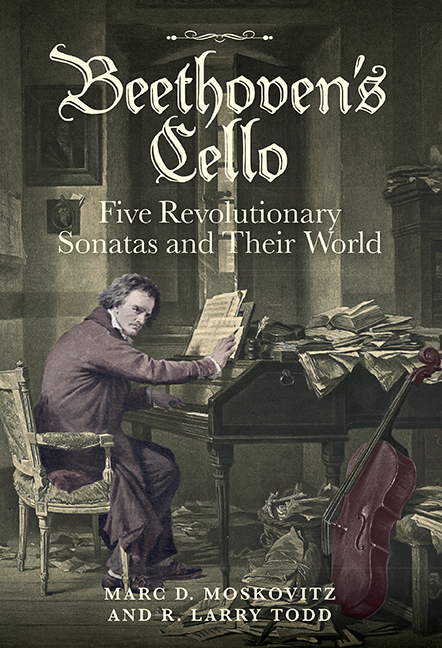Book contents
- Frontmatter
- Dedication
- Epigraph
- Contents
- Illustrations
- Foreword by Steven Isserlis
- Preface
- Personalia
- 1 From Bonn to Berlin
- 2 Music Fit for a King: The Sonata in F major Op. 5 No. 1 (1796)
- Interlude: Beethoven's Cellos
- 3 Tragic/Comic Masks: The Sonata in G minor Op. 5 No. 2 (1796)
- Interlude: Beethoven's Pianos
- 4 Themes and Variations
- Interlude: The Triple Concerto as Outlier
- 5 Friendship, War, Tears, and Grief: The Sonata in A major Op. 69 (1808)
- 6 Freedom and Control: The Sonata in C major Op. 102 No. 1 (1815)
- 7 ‘Most Remarkable and Strange’: The Sonata in D major Op. 102 No. 2 (1815)
- Interlude: Arranged Sonatas
- 8 Opus Posthumum
- Appendix 1 Primary Sources of Beethoven's Music for Cello and Piano
- Appendix 2 Reviews of Beethoven's Cello Music by His Contemporaries
- Notes
- Bibliography
- Index of Works by Beethoven
- General Index
Interlude: Beethoven's Pianos
Published online by Cambridge University Press: 18 April 2018
- Frontmatter
- Dedication
- Epigraph
- Contents
- Illustrations
- Foreword by Steven Isserlis
- Preface
- Personalia
- 1 From Bonn to Berlin
- 2 Music Fit for a King: The Sonata in F major Op. 5 No. 1 (1796)
- Interlude: Beethoven's Cellos
- 3 Tragic/Comic Masks: The Sonata in G minor Op. 5 No. 2 (1796)
- Interlude: Beethoven's Pianos
- 4 Themes and Variations
- Interlude: The Triple Concerto as Outlier
- 5 Friendship, War, Tears, and Grief: The Sonata in A major Op. 69 (1808)
- 6 Freedom and Control: The Sonata in C major Op. 102 No. 1 (1815)
- 7 ‘Most Remarkable and Strange’: The Sonata in D major Op. 102 No. 2 (1815)
- Interlude: Arranged Sonatas
- 8 Opus Posthumum
- Appendix 1 Primary Sources of Beethoven's Music for Cello and Piano
- Appendix 2 Reviews of Beethoven's Cello Music by His Contemporaries
- Notes
- Bibliography
- Index of Works by Beethoven
- General Index
Summary
PERFORMING OR LISTENING to a Beethoven cello sonata today is of course markedly different from what Beethoven or his contemporaries experienced. Beyond questions of tuning (Beethoven's ‘A’ was lower than modern A-440 concert pitch), of how to articulate a phrase, or of how loud to render a forte, for example, other factors, such as concert venues and their acoustics, and of course the cellos themselves affected Beethoven's conception of his sonatas. And surely among the most striking differences were in the pianos Beethoven used to play and compose, instruments that bore little resemblance to their modern counterparts.
Despite a history dating to the start of the eighteenth century, the fortepiano continued to develop throughout Beethoven's lifetime. Like cello and bow makers, keyboard makers worked in tandem with the players, searching for ways to improve the sound, response and power of their instruments, and not surprisingly Beethoven's personal preferences were of great interest to some of the most influential builders of the day. On more than one occasion, they happily placed their instruments at Beethoven's disposal, hoping to provide the discriminating virtuoso with an ‘ideal’ instrument. Though we have been now long familiar with the power and coloristic gradations of the modern concert grand, Beethoven's instruments possessed an intimacy and immediacy largely lost to us today (save perhaps on modern reproductions of fortepianos), and offered distinct advantages within the ensemble setting, qualities that the composer fully exploited.
Beethoven's keyboard preferences were evident early on. When he traveled with the Bonn court orchestra to Mergentheim in 1791, he refused to perform in public for lack of an instrument from the workshop of Johann Andreas Stein, whose keyboards he had already become accustomed to playing in Bonn. Once in Vienna, Beethoven wasted little time in searching out a suitable fortepiano, though there is no record of what he played until 1797, several months after his return to Vienna following the Berlin sojourn that produced his first two cello sonatas. In the latter half of that year Beethoven wrote two letters to Johann Andreas Streicher, whose family had moved its piano business from Stuttgart to Vienna in 1795.
- Type
- Chapter
- Information
- Publisher: Boydell & BrewerPrint publication year: 2017

